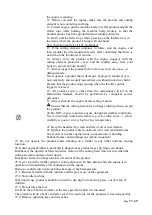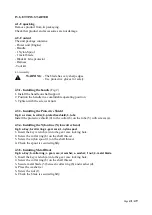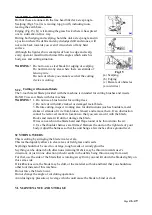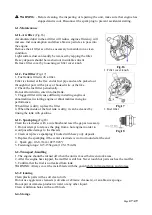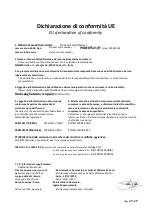
WARNING
- Before cleaning, the inspecting or repairing the unit, make sure that engine has
stopped and is cool. Disconnect the spark plug to prevent accidental starting.
6.1- Maintenance
6.1.1- Air filter
(Fig.16)
Accumulated dust in the air filter will reduce engine efficiency, will
increase fuel consumption and allow abrasive particles to pass into
the engine.
Remove the air filter as often as necessary to maintain in a clean
condition.
Light surface dust can readily be removed by tapping the filter.
Heavy deposits should be washed out in suitable solvent.
Remove filter cover by loosening air filter cover knob.
Fig.16
1. Filter cover knob.
6.1.2- Fuel filter
(Fig.17)
1. Fuel tank is fitted with a filter.
Filter is situated at the free end of fuel pipe and can be picked out
through fuel port with a piece of hooked wire or the like.
2. Check the fuel filter periodically.
Do not allow dust to enter into fuel tank.
3. Clogged filter will cause difficulty in starting engine or
abnormalities in starting engine or abnormalities in engine
performance.
When filter is dirty, replace the filter.
4. When the inside of the fuel tank is dirty, it can be cleaned by
rinsing the tank with gasoline
Fig.17
1. Fuel filter
6.1.3- Spark plug
(Fig.18)
Clean the electrodes with a wire brush and reset the gap as necessary.
1. Do not attempt to remove the plug from a hot engine in order to
avoid possible damage to the threads.
2. Clean or replace a sparkplug if fouled with heavy oily deposits.
Fig.18
3. Replace the sparkplug if the center electrode is worn or rounded at the end.
4. Spark gap: 0.6-0.7mm (.023".028")
5. Fastening torque: 145-155kg.cm (125-135in.lb)
6.2- Transport, handling
1. The engine should be turned off when the unit is moved between work areas.
2. After the engine has stopped, the muffler is still hot. Never touch hot parts such as the muffler.
3. Confirm that the fuel is not leaked from tank
WARNING: Always cover the metal blade with the guard while in transportation and storage
6.3- Cleaning
Clean plastic parts with a soft clean cloth.
Do not use aggressive cleansers (solvents or abrasive cleansers), or an abrasive sponge.
Do not put or immerse product in water or any other liquid.
Clean ventilation holes with a soft brush.
6.4- Storage
Page
47
/
49





